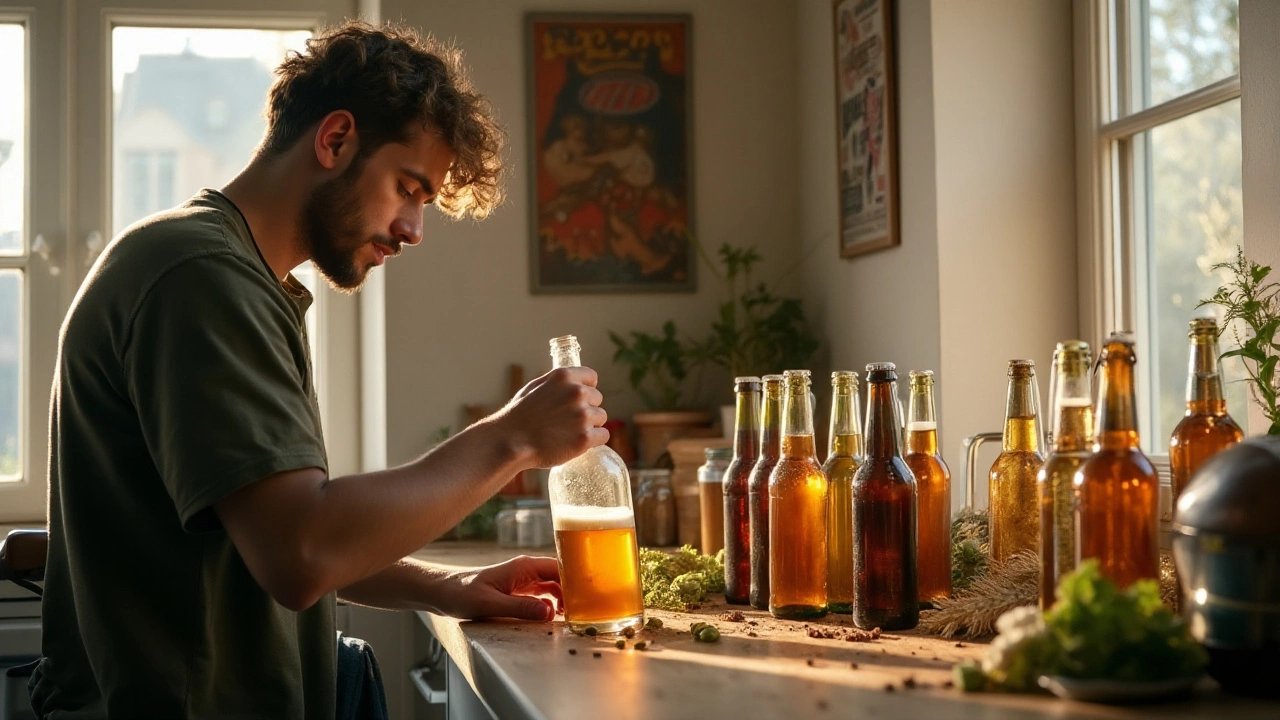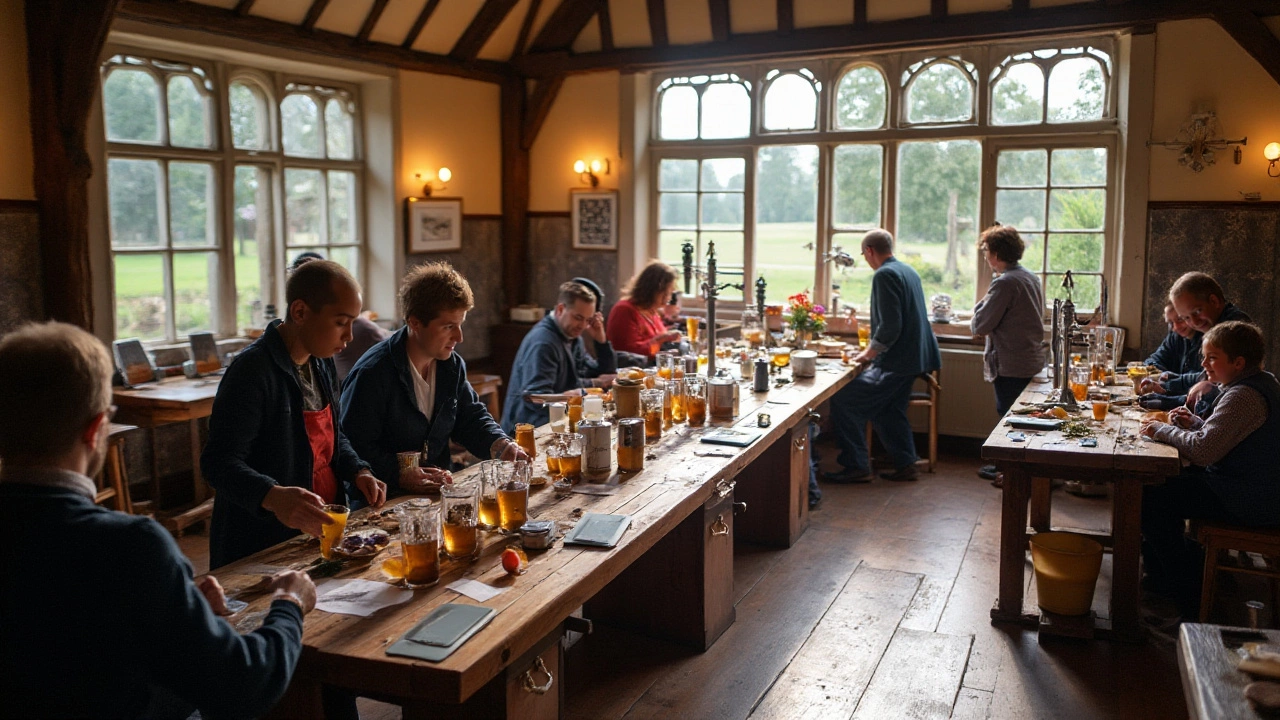For those passionate about beer, brewing your own can be an exciting endeavor. While it does require a fair bit of patience, the good news is that it doesn't need to be complicated. You'll be led through a fascinating journey of ingredients, fermentation, and flavors.
Start with understanding the stages involved in brewing which include preparation, fermentation, and finally conditioning. The average time for the entire process is about a month, but this varies with different styles of beer and personal techniques. From selecting the right kit to mastering the fermentation period, the end result—a refreshing homemade brew—is well worth it.
Whether you’re aiming to craft a pilsner, an IPA, or something entirely unique, remember that each brew can have its individual timeline and peculiarities. So roll up those sleeves, dive into the process, and enjoy the art of making your very own beer at home!
- Understanding the Brewing Process
- Choosing Your Brewing Kit
- Fermentation: The Waiting Game
- Pro Tips for a Delicious Batch
Understanding the Brewing Process
Diving into the world of homebrew beer, you'll find each batch begins an intriguing journey, steeped in tradition and creativity. The brewing process is a delicate orchestrate of art and science, a symphony that turns raw ingredients into the liquid gold many of us cherish. To truly grasp the essence of homebrew beer, one must understand the stages involved. The first step is preparation, where you gather your ingredients which typically include malt extract, hops, yeast, and water. Each of these plays a critical role; the malt provides the sugars needed for fermentation, while hops add bitterness and aroma. Yeast is the magical organism that consumes sugars and transforms them into alcohol and carbon dioxide. Water, often understated, is equally vital; it constitutes more than 90% of beer and can deeply influence the flavor and character of the brew.
Once your ingredients are ready, you'll move to mashing and boiling, where the malt's sugars are extracted into a sweet liquid known as wort. This step involves heating the mixture to help draw out these sugars and improve flow, setting the stage for the subsequent steps. Added hops during the boil impart essential flavors and aromas, with the timing of the addition affecting their impact. Knowing when to add hops can often be the difference between an ordinary beer and an extraordinary one; experienced brewers like to experiment with hop schedules to craft distinctive signatures in their beers.
After the boil, the wort needs to be cooled rapidly. This rapid cooling, typically done using a wort chiller, is crucial to prevent any contamination and prepare the beer for fermentation. Now comes the heart of the process: the fermentation phase. Here, yeast takes center stage, feasting on the sugars and producing alcohol and carbon dioxide. This phase can vary from a few days to several weeks, depending on the type of beer you're crafting. Ale usually ferments at warmer temperatures and faster, while lagers are more patient, requiring cooler temperatures and longer times to develop their rich flavors. Anthony Fogarty, a veteran brewer, once noted, "Understanding fermentation is akin to understanding life: it's all about balance and waiting for the right moment."
After fermentation, the beer is transferred into bottles or a keg, where it goes through conditioning—an extension of fermentation that allows further maturation. During this stage, beer develops its final flavors and carbonation. This is when patience is truly tested. It is crucial not to rush this part to allow the flavors to mature fully. A meticulously timed and conditioned beer is like a well-aged painting, slowly revealing complexities with each sip. The correct timing makes a world of difference, and with each passing day, your creation inches closer to that perfect pint you've been dreaming of. Many brewers maintain a keen record of their processes, noting environmental conditions and ingredient properties, allowing for a richer understanding and often opening the door to continuous improvement and refinement.
Finally, there's bottling and capping, marking the close of this fascinating process. Each step in brewing requires care, attention to detail, and, most importantly, a passion for creativity. Homebrewing is not just about following recipes, it's about understanding how subtle changes can transform the final product, and home brewing kits provide the perfect playground for this experimentation. Beer crafting at home is less a destination and more a journey; each batch is another story unfolding.

Choosing Your Brewing Kit
Diving into the world of homebrewing begins with selecting the right brewing kit, a decision that can make or break your first experience brewing beer at home. With an abundant array of options available, it’s essential to match your choice with your brewing goals and skill level. The choices range from beginner-friendly kits that provide a straightforward path to your first batch, to advanced setups that offer endless customization for the seasoned brewer.
For a novice, a basic home brewing kit is indeed the ideal starting point. These kits typically come with all the essential equipment such as a fermenter, airlock, thermometer, hydrometer, and a sanitizer. Some kits even include malt extract, which simplifies the process considerably. If you’re opting for a more sophisticated taste, consider kits that offer partial-mash options, allowing for a mix of malt extract and home-milled grains. Not only do these kits provide a flexible way to experiment with flavors, but they also serve as a gentle introduction to the more complex aspects of beer brewing.
Customizing Your Experience
As you gain confidence, you might find yourself tempted to customize and expand your setup. At this point, it’s beneficial to consider what type of beer you’re most interested in creating. Are you aiming to craft vibrant IPAs, rich stouts, or refreshing lagers? Each style can benefit from slightly different equipment. For instance, if ales are your go-to choice, temperature control becomes less of an issue, but those looking to brew lagers will need a space to maintain cooler temperatures consistently.
"A good brewing kit is like a primer on the art and science of beer-making," says Greg Hughes, author of 'Home Brew Beer.' "The right tools can elevate your experience and result in superior quality brews."
An advanced kit often includes additional gadgets such as an immersion chiller for rapid cooling, a bottling wand for easier transfer, or even kegging equipment for those keen on dispensing beer like a pro. Remember, investing in quality equipment not only enhances your brewing journey but can also ensure better-tasting beer. Prices for these kits can vary significantly, with basic setups starting as low as $80, while more comprehensive systems can reach several hundred dollars. Below you can find a quick comparison of what's typically involved:
| Kit Type | Included Equipment | Price Range |
|---|---|---|
| Basic Starter Kit | Fermenter, thermometer, airlock, hydrometer, sanitizer, basic ingredients | $80 - $150 |
| Intermediate Kit | Partial-mash options, additional fermenters, bottling bucket | $150 - $300 |
| Advanced Kit | Grain mill, immersion chiller, kegging system, temperature control | $300+ |
When it comes to choosing the perfect kit, take into account the space you have available for brewing and storage, as well as your budget and time commitment. Each kit out there offers a unique approach to the beer crafting experience. Remember to read reviews and perhaps even join homebrewing communities online to gather insights from experienced brewers. With a combination of the right tools and a pinch of passion, you’ll be well on your way to enjoying your crafted brew before you know it!

Fermentation: The Waiting Game
Fermentation is the heart of homebrew beer production, a magical transformation where the sugar in the wort—what they call pre-beer—is eaten by yeast to create alcohol and carbonation. This process is the crux of any brew, whether you're tinkering with an India Pale Ale or exploring the deep complexities of a stout. This phase can often feel like a waiting game, demanding patience and attentiveness, testing your ability to not rush things even when your excitement is bubbling over.
The Fermentation Timeline
Typical fermentation for most home-brewed beers can take anywhere between one to three weeks, making it the longest phase in the brewing cycle. As the yeast starts its work, you’ll notice a dramatic change in your once cloudy and sweet wort. During the initial week, a frenzy of activity occurs in your fermentation vessel. This primary fermentation may calm down after the first seven days, but the yeast continue their labor quietly, cleaning up any unwanted components that could affect flavor.
"In the world of brewing, patience is always rewarded. A rushed beer is never a good beer," says Charlie Papazian, an authoritative voice in home brewing.
Home brewers often debate the optimal time. Some brave souls believe in extended fermentations, asserting that lagers and certain ales benefit from additional time to develop subtle nuances. This secondary fermentation can last a further two weeks up to several months for those willing to invest time in pursuit of perfection.
Monitoring Temperature and Conditions
Your beer quality is significantly influenced by the conditions under which fermentation occurs. Maintaining a stable temperature tailored to the yeast strain you're using is crucial. Most ale yeasts are happy between 18°C and 22°C, while lager yeasts prefer cooler climes of 7°C to 13°C. Keeping your fermentation vessel in an environment that suits these temperatures will help ensure that your homebrew beer doesn’t develop off-flavors.
Key Indicators
- Aromas: Your keen nose will notice unique aromas emerging, some fruity or estery depending on yeast and temperature.
- Activity: You’ll see active fermentation when bubbles escape through your airlock.
Some brewers obsessively watch the specific gravity using a hydrometer or refractometer to measure the fermentation progress accurately, while others simply watch for visual cues and trust in the timing. Both methods have their merits in this very hands-on craft.
Ultimately, the successful ferments come from careful balancing, akin to orchestrating a fine symphony where yeast plays every note perfectly. Allowing for proper fermentation will grant you a brewing masterpiece worthy of the time invested, and the first sip of your small-batch triumph will attest to the virtues of patience. Now, onto the final step of bottling and anticipating that moment of crisp, cold satisfaction that makes every home brewer say, "That was worth the wait."

Pro Tips for a Delicious Batch
Crafting a scrumptious homebrew beer requires more than just following a recipe. It involves precision, creativity, and a bit of intuition. Starting with your ingredients, consider the quality and origin. Pay close attention to the freshness of your hops and malts. Fresh and high-quality ingredients contribute immensely to the beer's flavor profile. It's akin to cooking—using fresh herbs can transform a dish into something extraordinary. When you open your packet of hops, the aroma should be vibrant and inviting, not stale or mildewy. Likewise, grains should have a rich, earthy fragrance, akin to freshly baked bread.
Sanitation is another backbone of a successful brew. Any contamination can alter the taste, turning your potential masterpiece into a wasted effort. A clean workspace is not just ideal but necessary. Use sanitizing agents specifically designed for brewing, and let every piece of equipment soak adequately. About this, experienced brewers frequently say 'sanitize anything that touches your beer after the boil.' Ensuring this level of cleanliness will guard your brew from bacteria and wild yeast, common culprits of off-flavors.
“The bitterness brewed into a beer is like the salt to your soup—it needs to be just right,” says an anonymous expert. This principle reiterates the importance of balance across all ingredients.
Effective temperature management can make or break your fermenting beer. Keep it cool during fermentation to maintain a friendly environment for your yeast, with most ale yeast varieties thriving between 18-22°C (about 64-71°F). Temperature fluctuations can stress the yeast, resulting in unwanted flavors. To aid with this, some homebrewers invest in temperature-controlled fermenters—an investment that can drastically improve brew consistency.
Experimentation is an intriguing side of homebrewing. Once you have a few batches under your belt, don’t shy away from personalizing your recipes. Adding fruit, spices, or even herbs can become your signature touch. Keep a brew log with detailed notes on each brew, including any deviations from the standard process and their effects. This documentation isn’t purely for nostalgia—it’s instructional and diagnostic, offering clues on how or why a particular batch might have turned out as it did.
Finally, patience remains truly a virtue in the realm of homebrewing. After bottling, give your beer time to condition. Adequate conditioning allows flavors to mature, often smoothing out harsh notes and enhancing aromatic elements. The wait might be agonizing initially, but great things take time. At an average of two to three weeks, this maturation period can be the magic touch for your crafted brew. Remember, the homebrew beer journey is about both the process and the product. Enjoy every moment and every sip.


